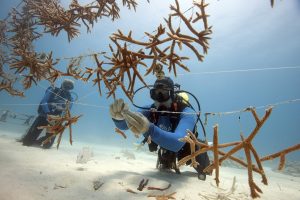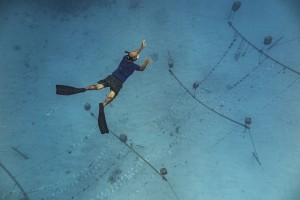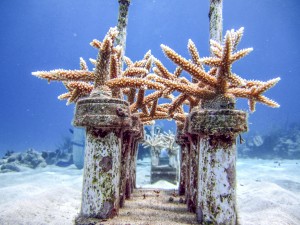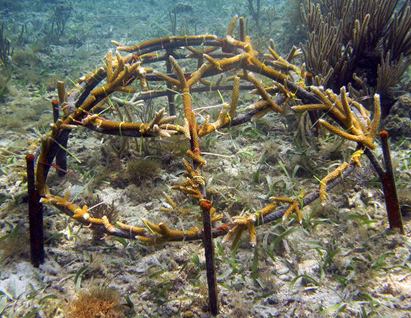Coral Nurseries
A common prerequisite for coral propagation is the establishment of nurseries that are used to generate and supply large numbers of corals that will be later outplanted onto reefs. Coral nurseries are a critical component of this process because they provide a location where corals can be propagated and grown.
Coral nurseries can be field-based (‘in situ’) or land-based (‘ex situ’). While both nursery types can generate large numbers of coral colonies, there are advantages and disadvantages to each that ultimately depend on the resources and objectives of the restoration program.
Field-based nurseries
Most coral nurseries to date are field-based, often in an area off-site from natural reefs. Advantages of these nurseries include their relatively low cost and low technology methods, allowing for less skilled or experienced personnel to be involved in maintaining them. Disadvantages are that these nurseries are more susceptible to environmental extremes like warm temperatures or strong storms that can damage nursery corals and structures.

Floating PVC tree used for growing and rearing staghorn corals. Tavernier, Florida. Photo © Coral Restoration Foundation
There are two main types of structures used for field-based coral nurseries: floating and fixed structures.
Examples of floating structures include:
- Coral trees
- Line Nurseries
- Floating Underwater Coral Apparatus
- Floating Tables
Examples of fixed structures include:
- Blocks
- Tables
- A-frames and domes
Land-based nurseries
Nurseries located on land are increasingly being used for coral gardening. Advantages of these nurseries include being sheltered from bleaching events, biological pests, and disease. Practitioners can manipulate environmental conditions to promote optimal coral survivorship and growth year-round and can regularly monitor and maintain facilities. Land-based nurseries can also facilitate methods of larval-based restoration and micro-fragmentation. Disadvantages are that these nurseries can be expensive, equipment can malfunction, and they require trained staff experienced in aquarium husbandry.
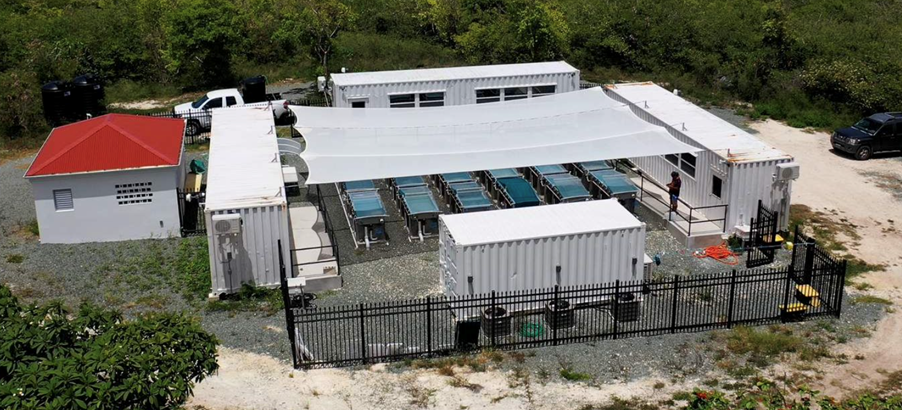
The Nature Conservancy USVI Programs land based coral nursery facility in St Croix USVI. Photo © MJS Vision
Each nursery type requires specific considerations, particularly regarding the type of structure and nursery site selection for field-based nurseries, and the special supplies, materials, and maintenance required for land-based nurseries.
Maintenance considerations are particularly important and include:
Water quality should be stable and maintained at optimum levels for coral growth. A regular water quality testing program should be in place with equipment on site.
Optimal water flow rates depend on which species are growing in a particular nursery and should always be alternating and turbulent if possible. Lower water velocity may keep corals alive but reduce growth and skeletal density.
Light levels should be similar to the natural habitat and depth where corals were originally sourced. There are two main sources of light in land-based systems: altered natural light (usually achieved through shading mechanisms) and artificial light (usually indoors).
Controlling overgrowth of corals by algae and other fouling organisms is one of the most time-consuming maintenance tasks in land-based systems. Manual cleaning of corals and tanks by trained practitioners is the most common method for reducing overgrowth by algae and other fouling organisms.
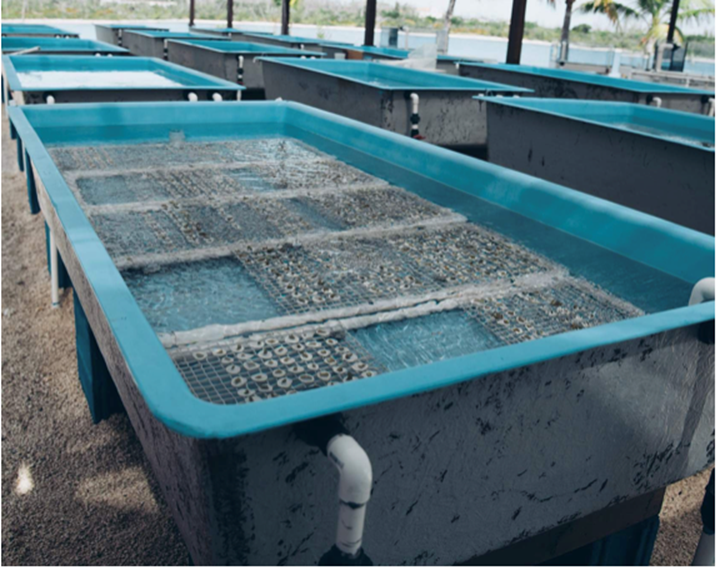
Tanks are arranged in line with sufficient walking space around them to facilitate maintenance. Photo © Harry Lee Coral Vita
Resources
Fragments of Hope Coral Restoration Manual
Regional Restoration Benchmarks for Acropora cervicornis
Caribbean Acropora Restoration Guide
Caribbean Acropora Restoration Guide
Active Coral Restoration: Techniques for a Changing Planet
Hawaii Division of Aquatic Resources Coral Restoration Implementation Guide
Coral Restoration Consortium Field-based Propagation Working Group
Coral Restoration Consortium Land-based Propagation Working Group

